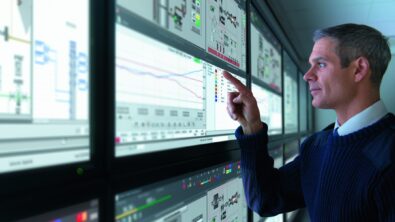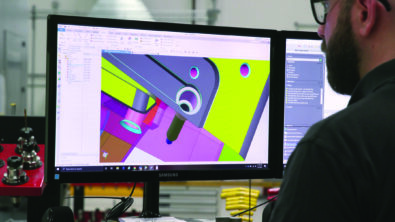Exploring Generative AI Part 2 – Transcript

In a recent podcast, I continued a conversation with Dr. Justin Hodges about the ways generative AI is reshaping the world of design and simulation. Check out a transcript of that talk here:
Spencer Acain: Hello and welcome to the AI Spectrum podcast. I’m your host, Spencer Acain. In this series, we look at a wide range of artificial intelligence topics from all across Siemens and how they’re applied to different technologies. In this episode, I’m once again joined by Dr. Justin Hodges, an AI/ML Technical Specialist and Product Manager for Simcenter to discuss the many ways in which Generative AI is impacting the world of computer aided engineering, simulation and product design.
Last time you talked a lot about the applications of Generative AI and how it can help alleviate what you call the dull, dangerous, dirty, and difficult tasks and lift those from humanity, shoulders and the many applications of basically creating kind of AI knowledgebases and helping systems that can take the place of an expert on the shoulder of somebody working on difficult tasks and software. But beyond that, how do you see Generative AI coming into play in the world of engineering and simulation?
Dr. Justin Hodges: Yeah, so this is where it gets really nerdy and therefore why I really, really like it. So, I think that you see different approaches in engineering design philosophies. You see more and more approaches over time, and basically the whole point is, give me a better answer, give me a more optimally designed component, or things like that. And there are definitely some solid approaches in the playbook of Generative AI that can give you better designs if you integrate those approaches. So, this could be variational autoencoders, this could be GANs. Basically this idea of, help me get better designs.
In our simulation world at least, a lot of the methods are 30 years old or 20 years old, and they keep getting better and better, and it’s really cool to see integration of stuff like this. One thing I think of that’s a pretty relatable example is, it’s concerning our system simulation software, where I’m not designing something that’s pretty much set in stone like a car, I kind of know everything about the car at that point, but maybe something super early in the design phase where maybe I’m designing a drone and I don’t know if I want to power it with a battery or gas.
I don’t really know how much I want it to weigh. I don’t know if I want it for long distance or short distance. I don’t know how I want it to take off. I mean, at that point, you’re not just tweaking one little component, you’re tweaking a system of systems and there’s almost infinite number of possibilities for how you could design it. And I think in generative engineering, and with machine learning there in the background as the engine on how that’s possible, we have more and more techniques that can help you get the optimal designs when you do have an inconceivably large amount of options.
So, that’s definitely a place I hope it makes sense, but the situations where you’re early in the design process and there’s just too many options and it’s overwhelming, that’s certainly one area. The other, which could be relatable if you’re designing end stage, further along the design process, and you’re just focused on certain components. So, in this case, you can use these techniques and generate AI to generate new geometries or to do maybe reverse engineering or inverse design. Have you heard of that before?
Spencer Acain: Yeah, I’ve heard a little bit about reverse engineering, but I’d love it if you could explain more, maybe give us a little more detail, go into a little more in-depth on that?
Dr. Justin Hodges: Yeah, sure. Let’s say I want to design, flow through a duct. My process may be sequential and iterative to how I change the design. So, I run a simulation, I look at the results, whether it automated with an algorithm for a cost function or just myself with my eyes. I’ll tweak something in the geometry and then change it again and see how the results change. So it’s very forward in the sense that I changed the geometry and then I look at the results and see what they are. In that approach that I described, whether you want to call it reverse engineering or inverse design, it’s probably better to call it inverse design, I guess. By doing the opposite, I am specifying the results and setting them as a field to say, this is the constraint. So, I’m imposing the results rather than imposing the geometry, and then I’m solving what the geometry would be to have to satisfy that constraint of the results looking the way they do.
And yeah, it could be a machine learning model there that is able to provide such a connection and be able to learn from simulation data and then provide the matching or the correlation between results and geometry. So, in that case, it’s generative. You’re generating a piece of geometry or a surface or design or a set of design parameters that satisfy your requirements for how that part should perform. I’ve done that firsthand, and it’s pretty fun. It can take 90 seconds if you have a machine learning model that’s spitting out inference over and over and over again in an optimization cycle. So, yeah sure, it’s not going to always work, it’s going to have its own nuances and limitations like anything else. But hey, that’s 90 seconds. That beats the former approach where I have to run a simulation and then iteratively change every single time. Maybe one simulation best case scenario takes 90 seconds. It’s not often, it would, depending on the type of simulation, it could be a lot longer.
Spencer Acain: Yeah, you could very easily spend days or even weeks on that if you have to run a lot of complicated simulations in the forward method where you’re starting with a design and then figuring out how it performs, it sounds like.
Dr. Justin Hodges: Yeah, it’s usually the union of the two, sorry to interrupt, here’s the union of two.
Spencer Acain: Oh, no, go ahead.
Dr. Justin Hodges: I’ve got the run, maybe it’s flow simulation, right? So I’ve done those as a company, I have those in my historical databases. Maybe it’s a campaign that could take a month to do again and run more simulations, or maybe if I establish this as a method, I can train the machine learning model, based on that history of data, history of simulations I have, and then I can take some time to set up this inverse design philosophy, and then I can do these generative predictions, where it’s creating and telling me what the best geometries are. If that only takes a couple minutes to run or a very relatively shorter amount of time, maybe I could do that a few times and then essentially let that proceed where I run simulations.
It’s like a huge headstart into my design space on where I should look, designs I should consider, et cetera, and then that way when I do go forward and I use my trustworthy, vetted traditional approaches of simulation, I at least have a huge headstart on what might be the best place in the design space to get the most optimal result. So, there’s really a union of the two. Some people are afraid it’ll just wipe out engineering or the workforce, but I don’t see it that way. I really see it as a tool to just supplement.
Spencer Acain: Yeah, I agree with that. AI is never, I wouldn’t say never maybe but, at least not for the very long foreseeable future, it’s not going to be able to replace what a human designer or human expert can do. Like you mentioned at the beginning, it’s a powerful tool for making life easier for these experts. It cuts out stuff that would take a very long time or stuff that is tedious and it says, hey, rather than, like you said, that month long investigative period, you’re doing, you just take a few minutes, just run these simulations, and now you’ve put yourself in a much better position moving forward into this design space that you’re exploring.
Dr. Justin Hodges: I really like that quote, lift the dull, difficult tasks so we can focus on the essence of our work. And like you said, I mean, you may still take one month to do the flow simulation study, but hey, if you have a huge headstart, then the outcome is, your designs are just better. So, in that case, no one’s losing their job, people are just making more performant designs, which is great.
Spencer Acain: So, I think you’ve kind of touched on this a little bit already with the idea of AI generating designs from these requirements. So, can you a little bit more explicitly talk about where you see AI fitting into the paradigm of requirement driven design software like Siemens own HEEDS tools, where you’re putting in these requirements and getting results out of it from multiple other sources of software.
Dr. Justin Hodges: Yeah, that’s nontrivial, right? I basically said, all these huge changes are involved, and it could be different approaches. So yeah, you’re right, naturally your software provider needs to be flexible and also provide more things to you. For example, training these models, I mentioned you use historical simulation data, right? Well, It’s not magic in the sense that it involves things like sampling and statistics and that sort of idea. That’s the basis for how you decide what data you need and how the data you have will create a model. Maybe you can realize in your dataset, your model will not be too good unless you run more simulation points in this design space or for certain values of these parameters.
So, you really need something like HEEDS that can provide you that analysis. And again, not as a machine learning expert, but as a flow simulation expert or heat transfer expert or any sort of specific domain as a non-AI expert, it needs to make that clear to you and then it needs to give you the tools to fix it. So, in that case, another use case for Generative AI is data augmentation. So, I can create synthetic CFD data to supplement my existing dataset, and then that way when I train my model on that, it’s more accurate. It’s more well-rounded, and the implication there is when I go use the model, it’ll be able to accurately predict in a lot more scenarios, which is great.
But even aside from the technical, we’re introducing a lot of things that, like you said, are a paradigm shift. When we do these sorts of things, we’re going to need different hardware like GPUs oftentimes. So, in that case, I mean it’s just a hardware shift as well in terms of architecture. And as well, we want this to be multi-agent, multi-worker, multi-active, whatever you want to call it. This is going to be data from a lot of different teams. These cycles of model predictions are going to be faster. So, a lot of people will want to run their own experiments. So, you really need something like HEEDS Connect or some environment where it’s connected to a lot more databases, a lot more people. You can distribute whatever I do to you and to others, so we can all sort of learn from it.
Data management, access obviously is a huge part of this right? Now you need to have this thing all connected so models can pull data and train, and then when you make models, you have to have versioning and storage and deployment, which are unique concepts as far as sys goes and software because when we release Simcenter STAR-CCM+, that’s a version, and you’ll have another one coming out a few months later. But you can make several versions of a machine learning model in the same day, and they could be used for different purposes, conservative, aggressive, different kinds of models with different levels of tolerance for risk or uncertainty. So you really also need a part of this ability to version and store and deploy without getting messy. So horizontal products like HEEDS are quite important for that as we see this growth of Generative AI and just machine learning in general, I would say.
Spencer Acain: So, it sounds like this requirement driven design, and then in relationship with these other tools like HEEDS is going to be very, almost more important moving forward, where you’ll need a way to, where it’s already a very valuable tool for connecting different aspects of a design process or different areas of expertise or domains, really. And now that you’re also throwing AI into the mix, you really need this here as a layer where everything can connect and then it can connect the models into everything, almost.
Dr. Justin Hodges: Exactly. I don’t mean to make it overly complex or convoluted. Look at this aspect pushed all the way to the extreme, to the asymptote, like Facebook or Twitter, for example. How many different sources of information or data are there? All the users, all their activities, all their scrollings, things that they do and don’t like, ads they click on and don’t, right? That’s a lot of data to manage as well as the models that are learning and then progressively providing them with new content that are estimated to be to their liking.
So, in that case, that’s an upper limit of how connected and flexible and quick in terms of deployment of these models. This is a very different scenario than just making machine learning model in your own little Python laptop, saving it to your local machine and saying, I did my task. I ran my simulation, and that’s it. Now, we need these products to connect them all together, so that people can really make use of them and I think that’s just like you said, perfectly. It’ll be a paradigm shift in terms of the software that we use as we generate data, even through traditional software like flow simulation. Those things will still be integral, we just need layers on top.
Spencer Acain: Thanks for that great answer, Justin. I think we are about out of time for this episode. So, once again, I have been your host, Spencer Acain, joined by Dr. Justin Hodges on the AI Spectrum podcast and I encourage you all to tune in next time as we continue our discussion about Generative AI.
Siemens Digital Industries Software helps organizations of all sizes digitally transform using software, hardware and services from the Siemens Xcelerator business platform. Siemens’ software and the comprehensive digital twin enable companies to optimize their design, engineering and manufacturing processes to turn today’s ideas into the sustainable products of the future. From chips to entire systems, from product to process, across all industries. Siemens Digital Industries Software – Accelerating transformation.


